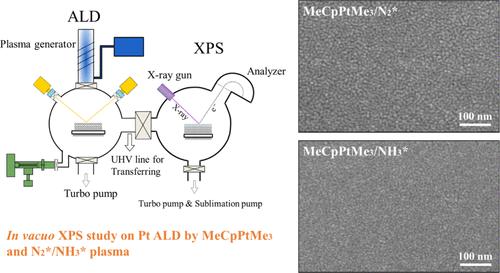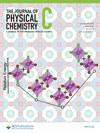In Vacuo XPS Study on Pt Growth by Atomic Layer Deposition Using MeCpPtMe3 and N2/NH3 Plasma
IF 3.3
3区 化学
Q2 CHEMISTRY, PHYSICAL
引用次数: 0
Abstract
Atomic layer deposition (ALD) has been an attractive tool in the fabrication of Pt thin layers and nanoparticles. In this work, the surface chemistry of Pt ALD through the MeCpPtMe3/N2-plasma (N2*) and the MeCpPtMe3/NH3-plasma (NH3*) processes at 300 °C have been investigated in detail using in vacuo X-ray photoelectron spectroscopy (XPS) during the ALD process, so that the evolution of surface species at each step of the ALD cycle can be studied under growth relevant conditions. In particular, the nature of the N-containing surface species and their role in the surface reactions during nucleation and steady growth are carefully scrutinized. Both processes are completely O-free. Persistent surface N and/or C species are detected, which are, however, not built into the film. Remarkably, the common N-species seen in other metal ALD processes by N-based plasmas, such as metal-NHx groups or N adatoms, are not present on the growth surface. For the MeCpPtMe3/N2* process, −CN-Hx is identified as the main N-containing species engaged in surface reactions. On the other hand, N-containing species seem to play an insignificant role in the NH3* process. It is revealed that the surface species and reaction pathways of the MeCpPtMe3/N2* and the MeCpPtMe3/NH3* processes are not only different to those of the O-based processes but also differ from each other. On the basis of surface species quantification results, a growth mechanism is proposed for the N2* and the NH3*-based processes, respectively. Our results show that N-based plasmas are a promising alternative to O-based reactants in Pt ALD growth.

通过使用 MeCpPtMe3 和 N2/NH3 等离子体进行原子层沉积实现铂生长的真空中 XPS 研究
原子层沉积(ALD)是制造铂薄层和纳米粒子的一种极具吸引力的工具。在这项工作中,我们使用空位 X 射线光电子能谱(XPS)详细研究了在 300 °C 下通过 MeCpPtMe3/N2- 等离子体(N2*)和 MeCpPtMe3/NH3- 等离子体(NH3*)工艺进行铂原子层沉积(ALD)的表面化学性质,以便在与生长相关的条件下研究原子层沉积循环每一步的表面物种演变。特别是对含 N 表面物种的性质及其在成核和稳定生长过程中的表面反应中的作用进行了仔细研究。这两个过程都完全不含 O。我们检测到了持续存在的表面 N 和/或 C 物种,但它们并不存在于薄膜中。值得注意的是,在其他使用 N 基等离子体的金属 ALD 过程中常见的 N 物质,如金属-NHx 基团或 N adatoms,并没有出现在生长表面。在 MeCpPtMe3/N2* 过程中,-CN-Hx 被确定为参与表面反应的主要含 N 物种。另一方面,含 N 物种似乎在 NH3* 过程中作用不大。研究表明,MeCpPtMe3/N2* 和 MeCpPtMe3/NH3* 过程的表面物种和反应途径不仅与基于 O 的过程不同,而且彼此也有区别。根据表面物种定量结果,分别提出了基于 N2* 和 NH3* 过程的生长机制。我们的研究结果表明,在铂 ALD 生长过程中,N 基等离子体有望替代 O 基反应物。
本文章由计算机程序翻译,如有差异,请以英文原文为准。
求助全文
约1分钟内获得全文
求助全文
来源期刊

The Journal of Physical Chemistry C
化学-材料科学:综合
CiteScore
6.50
自引率
8.10%
发文量
2047
审稿时长
1.8 months
期刊介绍:
The Journal of Physical Chemistry A/B/C is devoted to reporting new and original experimental and theoretical basic research of interest to physical chemists, biophysical chemists, and chemical physicists.
文献相关原料
| 公司名称 | 产品信息 | 采购帮参考价格 |
|---|
 求助内容:
求助内容: 应助结果提醒方式:
应助结果提醒方式:


